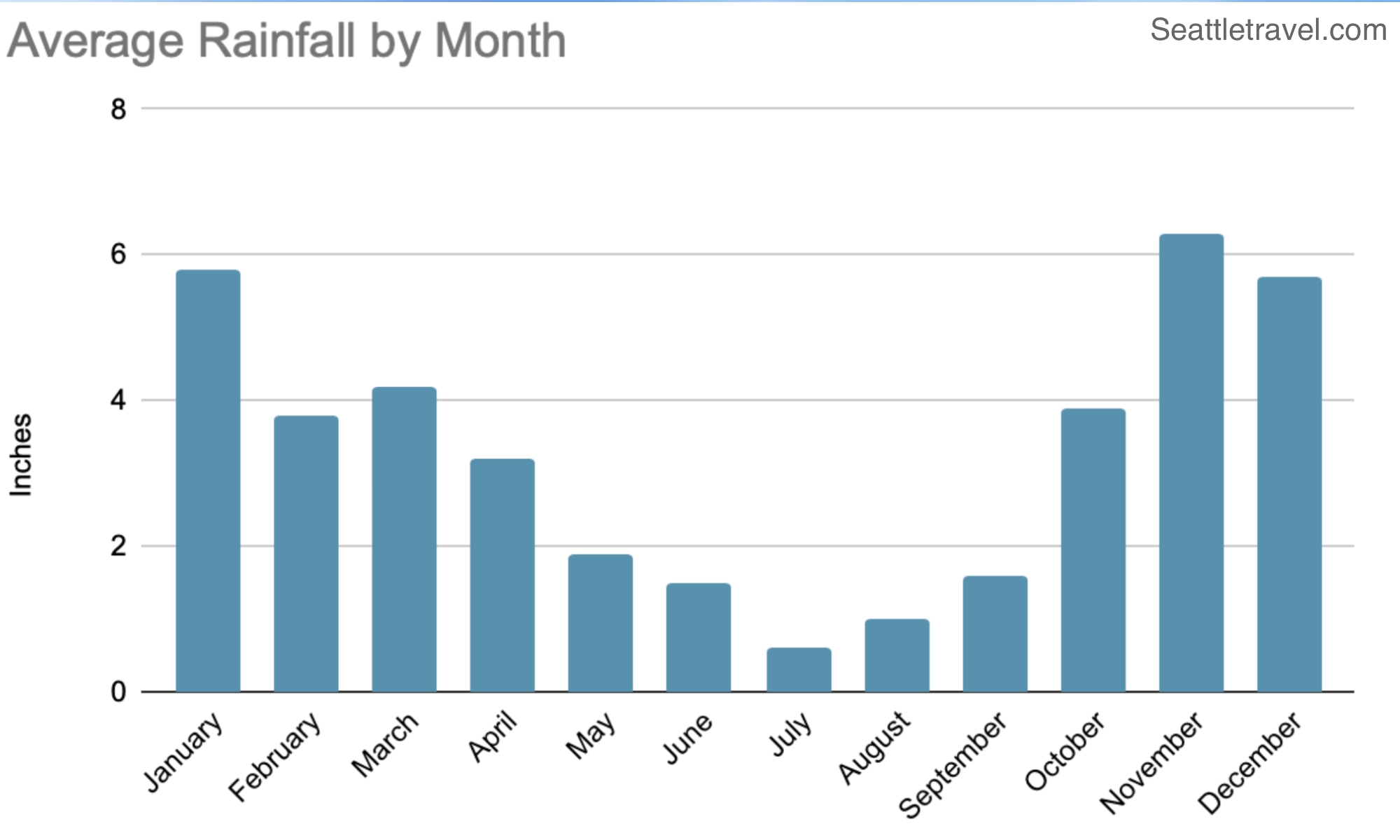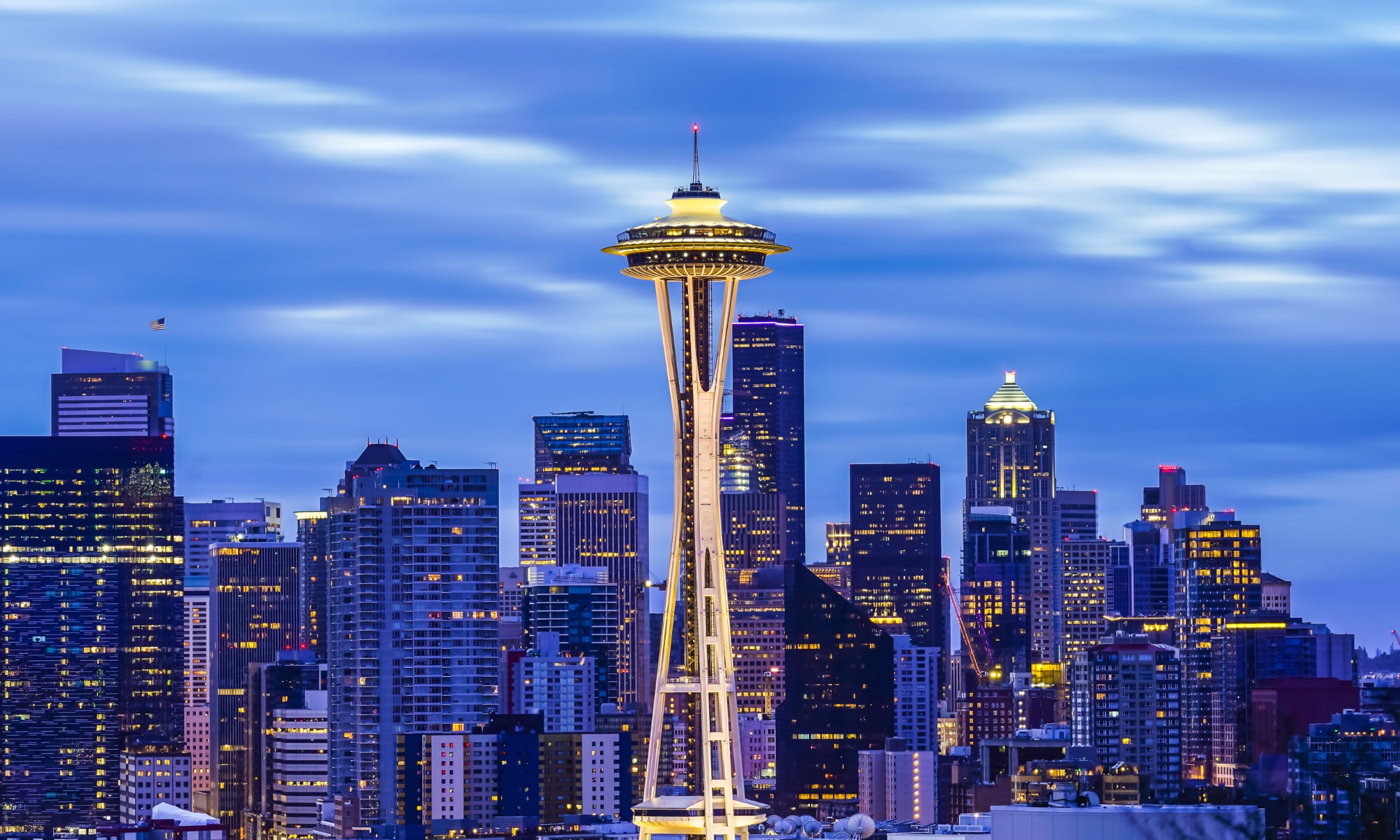Seattle is so famous for its rain, but is this reputation well-earned? The truth is, Seattle’s climate experiences major shifts throughout the year, and whether or not the city is exceptionally rainy or not depends on when you’re visiting.
Let’s take a deep look at whether it actually always rains in Seattle. We’ll dive into Seattle’s average annual rainfall versus other U.S. cities, how much it rains in Seattle per year, and what months see the most and least rainfall. Let’s get started!
Does it Really Always Rain in Seattle?
No, it doesn’t always rain in Seattle. The city sees less total rain (39.3 inches per year) but has more rainy days (156 days) than most major cities. So, while Seattle’s reputation as a rainy city is well-earned, the city has both dry and wet months.
Now, you might be wondering just how both of those things – lots of rainy days but low total rainfall – can be true at the same time. To explain, let’s first take a look at the geography of the area.
Seattle is surrounded on both sides by water. Puget Sound, an inlet of the Pacific Ocean, on the West, and the nearly 22-mile-long Lake Washington on the East. It is one of the many cities claiming to be built on seven hills, with elevation varying from sea level to 520 feet above sea level. Further in each direction, Seattle is surrounded by two mountain ranges, the Olympic Mountains of the Olympic Peninsula to the West. To the East of Seattle, you’ll find the Cascade Mountain range, which cuts the state in half as it runs from Canada to Northern California.
As you’ll soon see – the city is nestled between these two mountain ranges and water protects Seattle from extreme climate events. It moderates temperature extremes and reduces the ferocity of storms coming in from the Pacific Ocean that would otherwise drop more rainfall on the city.
What is Seattle’s Annual Rainfall?
Seattle receives just over 39 inches of rainfall on average per year. If that doesn’t seem very high to you, it’s because it’s not! Many other major metropolitan areas receive more average rainfall than Seattle does. Take a look at how it compares:

On an average year, Seattle receives less than ⅔ the average rainfall of Miami and New Orleans. Houston, Atlanta, New York, Washington DC, Chicago, and Kansas City all have greater average annual rainfall.
How Does Seattle’s Rain Compare to Other Cities?
So, where did Seattle’s reputation as being such a rainy city come from? It’s more about the number of rainy days rather than the amount of rain. It rains an average of 156 days per year in Seattle. Take a look at how Seattle compares to those same cities when we compare the average number of rainy days and that reputation suddenly makes sense.

Seattle is suddenly at the top of the list! Portland is nearly identical, averaging 155 days per year with measurable precipitation. Miami is next on the list, averaging 141 days per year.
How Does Seattle Have So Many Rainy Days and So Little Average Rain?
Seattle’s rain primarily comes from stratus clouds, which are thin and flat clouds that tend to carry very little, if any, precipitation. Heavy rains come from cumulonimbus clouds, which are also responsible for thunder. These clouds are so rare in Seattle, the city averages just seven days of thunder per year.
Rain is often referred to in Seattle by words like ‘drizzle’ and ‘mist.’ This is also why so many Seattlites don’t even own an umbrella! Many locals take not using an umbrella as an act to be proud of, so much so that the city’s last and only dedicated umbrella store closed in 2017. It’s more common to own a jacket with a hood for rainy days.
Why is Seattle’s Climate So Unique?
Seattle is nestled between the Puget Sound, the Olympic Mountains, the Hoh Rainforest to the West, and the Cascade Mountain range and the dry plains of Eastern Washington to the East. These mountain ranges leave Seattle well protected. As storms come in from the Pacific, the height of the Olympic Mountains causes storms to lose much of their precipitation in the Hoh Rainforest before the storms can reach Seattle. The Cascade Mountains shield the area from the dry and extreme temperature air of the continental plains.
Believe it or not, some sources consider Seattle to have a Mediterranean climate! Although others consider it a Marine climate like that of Northwestern Europe. The most accurate classification seems to be a dual climate zone with Mediterranean summers and Marine winters.
When You Can Avoid the Rain in Seattle
If that Mediterranean climate sounds good to you, plan your trip to Seattle in the summer. The dry season in Seattle is from mid-June through mid-September. During that time, the area averages under one inch of rain a month! This chart clearly shows when the dry time of year is!

November is clearly the rainiest month, with an average of 6.3 inches of rain in an average year! July is the least rainy month, averaging only 0.6 inches of rain. That’s less than 10% of November’s precipitation!
Do note though, in recent summers it’s become increasingly common for wildfires to create air quality issues towards the end of summer. If you have certain health conditions or are particularly affected by smoke, you may want to plan accordingly.
So Does It Really Always Rain in Seattle?
October through May, yes, it does rain in Seattle on a lot of days. However, it will most likely rain a very small amount. The rain doesn’t keep most locals from enjoying outdoor activities and it doesn’t have to keep you from enjoying them either!


